|
Boletín de la Sociedad Geológica Mexicana Volumen 75, núm. 1, A300822, 2023 http://dx.doi.org/10.18268/BSGM2023v75n1a300822
|
 |
Biostratigraphy of Yazdanshahr No.2 section in Kerman area, Central Iran, based on conodont communities
Bioestratigrafía de la sección Yazdanshahr No.2 en el área de Kerman, Irán central, con base en comunidades de conodontos
Ehsanollah Nasehi1,*, Mohammad Amin Nasehi2
1 Department of Geology, Faculty of Sciences, Islamic Azad University, Khorasgan branch, Esfahan, Iran.
2 School of Geology, College of Science, University of Tehran, Tehran, Iran.
* Corresponding author: (E. Nasehi) This email address is being protected from spambots. You need JavaScript enabled to view it.
How to cite this article:
Nasehi, E., Nasehi, M. A., 2023, Biostratigraphy of Yazdanshahr No.2 section in Kerman area, Central Iran, based on conodont communities: Boletín de la Sociedad Geológica Mexicana, 75 (1), A300822. http://dx.doi.org/10.18268/BSGM2023v75n1a300822
Manuscript received: March 6, 2022; Corrected manuscript received: August 29, 2022; Manuscript accepted: September 9, 2022.
ABSTRACT
Yazdanshahr No.2 section, which consists mostly of Bahram and Sibzar formations is located in the Zarand city, northern Kerman province (Central Iran). Five biozones have been identified based on the conodont community. The first biozone, which includes Padehat (15 meter) and Sibzar formations (75 meter), was distinguished based on genera Bipennatus and Icriodus and the probable corresponding age was considered to span Emsian to Eifelian. The second biozone is recognized by the first appearance of index taxon Polygnathus varcus (varcus Zone: early to middle Givetian). The third biozone starts with the firth appearance of the index genus Icriodus expansus (expansus zone: middle Givetian). The base of the Fourth biozone is recognized by the first appearance of the genus I. subterminus (subterminus Zone: middle to late Givetian) and the last biozone was distinguished with the first appearance of genera Ancyrodella and Polygnathus incompletes in the Givetain-Frasnian boundary (falsiovalis to crepida Zone?: Frasnian to Famenian?). Bahram Formation (94 meter) consists of Fossiliferous limestone (varcus to subterminus Zone) at the lower part, and alternation of dolomite and sandstone (falsiovalis to crepida Zone?) at the upper part. Sibzar Formation consists of Middle Devonian dolomite and limy dolomite containing intercalation of sandstone and limestone layers.
Keywords: Icriodus, Polygnathus, biozones, Bahram Formation, Devonian, Kerman, Iran.
RESUMEN
La sección Yazdanshahr No.2, que consiste en su mayor parte de las formaciones Bahram y Sibzar, se localiza en la ciudad de Zarand, provincial del norte de Kerman (Irán central). Cinco biozonas han sido identificadas con base en comunidades de conodontos. La primera biozona, que incluye a las formaciones Padehat (15 metros) y Sibzar (75 metros), se distingue con base en la presencia de los géneros Bipennatus and Icriodus, y la edad probable fue considerada en el rango del Emsiano al Eifeliano. La segunda biozona es reconocida por la primera aparición del la especie índice Polygnathus varcus (Zona varcus: Givetiano temprano a medio). La tercer biozona comienza con la primera aparición de la especie índice Icriodus expansus (Zona expansus: Givetiano medio). La base de la cuarta biozona es reconocida por la primera aparición de la especie Icriodus subterminus (Zona subterminus: Givetiano medio a tardío), y la última biozona fue reconocida con la primera aparición de los taxa Ancyrodella y Polygnathus incompletes, en el límite Givetaino-Frasniano (Zona? falsiovalis a crepida: Frasniano a Fameniano?). La Formación Bahram (94 metros) consiste en una caliza fosilífera (Zona varcus a subterminus) en su porción inferior, y de una alternancia de dolomita y arenisca (Zona? falsiovalis a crepida), en su porción superior. La Formación Sibzar consiste de una dolomita de edad Devónico Medio y una dolomita limosa, que contiene una intercalación de capas de arenisca y caliza.
Palabras clave: Icriodus, Polygnathus, biozonas, Formación Bahram, Devónico, Kerman, Irán.
- Introduction
The presence of Devonian and Lower Carboniferous deposits in Iran were first reported by Viquesnel (1850) and Loftus (1855), but the first stratigraphical studies of these sediments were carried out by Huckriede et al. (1962) in central Iran (Kerman area). These deposits have been known as red sandstone, dolomite, and fossiliferous limestone, and have been described as Jeirud Formation in the Central Alborz (Gaetani 1965; Assereto, 1963), Khoshyeilagh Formation in the northeastern Alborz (Bozorgnia, 1973), Moli and Ilanqareh formations (unofficial name?) in West Azerbaijan and Maku region in western Alborz (Alavi-Naini, 1993), Padeha, Sibzar and Bahram formations in Central Iran (Ruttner et al., 1968). Parts of these sediments located in the east of Central Iran have been named Padeha, Sibzar, Bahram and Shishtu formations (Ruttner et al., 1968; Stöcklin et al., 1965). The name of the Padeha Formation was given to an unfossiliferous sandstone, dolomite and gypsum unit in the Ozbak-Kuh mountains, which overlays thick fossiliferous, mainly carbonatic Niur Formation, and was overlain by the lead-bearing dolomitic Sibzar Formation comprising the age of Early to Middle Devonian. Type section of the Sibzar Formation is named after the Sibzar mine in Ozbak-kuh mountain (Eastern Iran). The name has been proposed for the dolomite unit containing the important lead deposits of Ozbak-kuh in Iran (Ruttner et al., 1968; Stöcklin, 1971). The contact between the overlying Bahram Formation and overlain Sibzar Formation is transitional (Ruttner et al., 1968; Stöcklin et al., 1965). The name of the Bahram Formation has been derived from Sar-Takhat-e-Bahram, a mountain located in the south of Ozbak-Kuh in East Central Iran (Ruttner et al., 1968; Stöcklin et al., 1965), and was applied to thick limestone unit in the Ozbak-Kuh mountain. The Bahram Formation itself, is predominantly overlain by alternation of shaly and sandy rocks of the Shishtu Formation (Ruttner et al., 1968; Stöcklin et al., 1965). This formation, the Bahram, can be correlated with the Jeirud Formation (Gaetani 1965; Assereto, 1963) in Central Alborz, the Khoshyeilagh Formation (Bozorgnia, 1973) in northeast of Alborz, the Zakeen Formation (Ghavidel Syooki, 1997) in Zagros, the Moli and Ilangareh formations (Alavi-Naini, 1993) in the Northwest of Alborz (Figure 2). In Iran, the most biostratigraphic research on Devonian sediments have been carried out based on Brachiopoda (Dastanpour 1996, 1998, 1999, Ahmadzadeh Heravi, 1971, 1975, Brice et al., 1999; Brice and Kebriaei, 2000), crinoids (Webster et al., 2003), 3vertebrate micro-remains (Hamdi and Janvier, 1981; Hairapetian et al., 2000), Palynomorph (Hashemi, 1998; Ghavidel-Syooki, 2001) and conodonts (Walliser, 1966; Ahmadzadeh Heravi, 1971, 1975, Weddige, 1984; Ashouri, 1990, 2004, 2006; Yazdi, 1999; Hairapetian and Yazdi, 2003; Wendt et al., 2005; Najjarzadeh et al., 2020; Gholamalian, 2005, 2007; Gholamalian and Kebriaer, 2008; Boncheva et al., 2007; Ahmadi et al., 2012; Bahrami et al., 2011a, 2011b, 2013, 2014, 2015, 2018; Nasehi, 2018; Bahrami et al., 2019, 2020, Zamani et al., 2020). The studied section is located in the southern margin of Kalmard Block (Fig 1), which has been formed during the Assyntic Orogeny to Early Cimerian Orogeny. Bahram Formation mostly consists of dark to light gray limestone rich in macrofossils such as brachiopods, corals and vertebrate micro and macro remains. (Figure 5). This Formation overlays carbonate sediments (mainly dolomite) of Middle Devonian Sibzar Formation, which itself overlays the evaporitic and detritic sediments of Lower Devonian Padeha Formation, and is overlain by light gray dolomite and limestone (probably Jamal Formation). In this research, more than 80 rock specimens (each 4kg) were sampled. via laboratory studies, 6 genera, 37 species and 9 subspecies of conodonts were recognized.
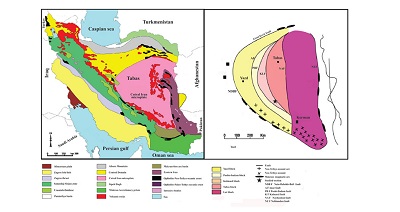 |
| Figure 1. Structural units of Iran with location of the Yazdanshahr No.2 section (after Königshof et al., 2017; Bahrami et al., 2020). |
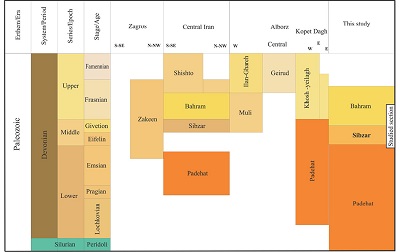 |
| Figure 2. Devonian stratigraphic correlation in Iran (After Nasehi, 2018). |
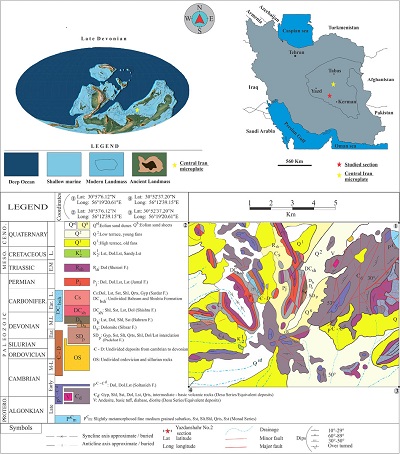 |
| Figure 3. Central Iran microplate position in the Late Devonian (After Scotese, 2014; Salehi et al., 2020) with Geological map of studied area (After Vahdati-Daneshmand et al., 1995). Abbreviations: M-L: Middle to Late, Ear.: Early, L: Late, Meso.: Mesozoice, Ceno.: Cenozoic, Lst: Limestone, Dol: Dolomite, Sst: Sandstone, Slt: Siltstone, F: Formation, Shl: Shale, Qrts: Quartzite, Gyp: Gypsum. |
- Geological setting
From a geographical point of view, Yazdanshahr no.2 section is located 47 kilometer north of Davaran village, located in Kerman province, central Iran, at the coordinates of 30°54́ˊ44.74˝N and 56°16ˊ30.82˝E, but from a tectonics point of view, it belongs to Kalmard block constituting the Central Iran micro plate (Figure 1). The investigated area is presented in figure 3, which illustrates the exact position of studied section (Yazdanshahr No2), and the distribution of stratigraphic units surrounding the section. These units ranging from Proterozoic (late Algonkian) to Cenozoic (Quaternary). this paper will investigate the Yazdanshahr No.2 section which have a thickness of 182 meter of Devonian sediments consisting of Padehat, Sibzar and Bahram formations. The base of the Yazdanshahr No.2 section starts with red Sandstone of Lower to Middle Devonian Padehat Formation (15 meter), which is overlain by dolomite and limy dolomite of Middle Devonian Sibzar Formation containing intercalation of sandstone and limestone layers. End of the section is recognized by Middle to Upper Devonian Bahram Formation, which starts mostly with fossiliferous limestone including brachiopods, vertebrate micro-remains, corals and conodonts to the alternation of dolomite and sandstone at the end of the section. This paper will concentrate on the biostratigraphy of Middle and Upper Devonian sediments of Yazdanshahr No.2 section, which mostly belongs to Bahram Formation. It is noteworthy that the Yazdanshahr No.1 section, which contains Padehat Formation was discussed in previous paper (2018).
| Table 1. Distribution of conodont species in studied section (Yazdanshahr No.2). |
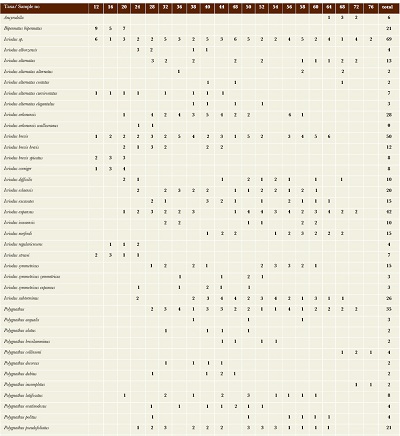 |
 |
| Figure 4. Representative examples of fossiliferous limestone fauna of Bahram Formation; (1) Coral (2) Cyrtospirifer (3) Fish teeth. |
- Methods of work
In order to determine the biostratigraphical aspects of the area under careful investigation, field sampling along with length measurements were undertaken systematically wherever a change in lithology was identified. In some cases, more than one sample was taken from the corresponding layer. The samples underwent the following preparation steps: crushing (in dimensions of three centimeters), acid treatment (acetic acid 10%), washing, sieving (sieve of 75,125,250 and 710 mesh), picking (with needle utilizing a microscope) and photography (with electron microscope); following which were carefully studied, and eventually, lead to identification of 6 genera, 37 species, and 9 subspecies. In order to determine the related biozones, the conodont biofacies models presented in following work were applied: Klapper and Ziegler (1979), Clausen et al. (1993), Narkiewicz and Bultynck (2007, 2010), Bultynck and Gouwy (2008), Narkiewicz (2011) and Bahrami et al. (2019).
- Biozonation of Yazdanshahr No.2 section
Conodont taxa of the Yazdanshahr No.2 section include 6 genera, 37 species, and 9 subspecies (Figure 5), which dominated by genera Bipinnatus and Icriodus in Eifelian, and Genera Icriodus and Polygnathus in Givetian, and genera Icriodus, Polygnathus and Ancyrodella in Frasnian belonging to the families Polygnathodontidae, Icriodontidae and Eugenathodontidae, and mostly consisting the shallow marine inner platform environment. According to conodont taxa and prevailing shallow-water setting of Yazdanshahr No.2 section, an alternatinve conodont zonation was applied for the middle to late Givetian (expansus and subterminus zone) based on different authors as follow: Narkiewicz and Bultynck (2007, 2010), Bultynck and Gouwy (2008), Narkiewicz (2011) and Bahrami et al. (2019). Other biozones were distinguished based on conventional biofacies model presented by Klapper and Ziegler (1979), Clausen et al. (1993). it is noteworthy to say that biozones are distinguished in the stratigraphical order, which means that the first biozone is the oldest, and the last one is the youngest.
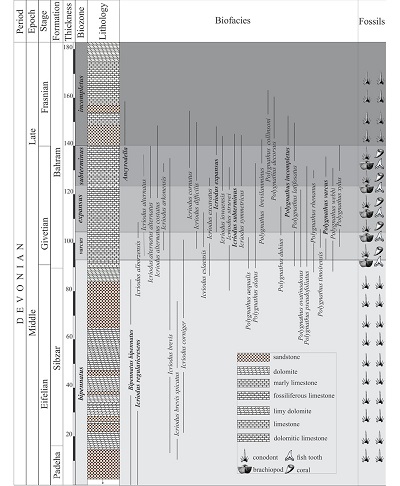 |
| Figure 5. Biostratigraphic column of Yazdanshahr No.2 section. |
4.1. SEROTINUS? / COSTATUS ZONE TO VARCUS ZONE (BIPENNATUS, ICRIODUS REGULARICRESENS ASSEMBLAGE ZONE)
First zone is recognized based on assemblage of bipinnatus and regularicresens species, which continues to the varcus Zone. lack of adequate index taxa made it impossible to correlate the findings with old global biofacies presented by Klapper and Ziegler (1979), Clausen et al. (1993). As such, the age of this biozone is Emsian? to Eifelian.
The elements collected in this part are related to Eugenathodontidae and Icriodontidae, and include the following genera: Bipennatus sp. (Philip, 1965), Bipennatus bipennatus (Bischoff and Ziegler, 1957), Bipennatus bipennatus bipennatus (Bischoff and Ziegler, 1957), Icriodus regularicresens (Bultynck, 1970), Icriodus struvei (Weddige, 1977), Icriodus brevis (Stauffer, 1940), Icriodus brevis brevis Stauffer, 1940, Icriodus brevis spicatus (Youngquist and Peterson, 1947).
4.2. VARCUS ZONE
Second zone is recognized by the first appearance of index taxon Polygnathus varcus, and ends with the first appearance of the Icriodus expansus, which belongs to the following zone.
Lithology of this biozone is gray brachiopod limestone, and abundant varieties of fossils that consist of brachiopoda, trilobites, coral, tentaculites and fish teeth.
The collected elements in this part are related to Polygnathodontidae and Icriodontidae, and include the following genera: Icriodus (Branson and Mehl, 1934), Icriodus alternatus (Branson and Mehl, 1934), Icriodus alternatus cymbiformis (Branson and Mehl, 1938), Icriodus brevis (Stauffer, 1940), Icriodus brevis brevis (Stauffer, 1940), Icriodus brevis darbyensis (Klapper, 1958), Icriodus incrassatus (Youngquist and Peterson, 1947), Icriodus incrassatus incrassatus (Youngquist and Peterson, 1947), Icriodus arkonensis (Stauffer, 1948), , Icriodus symmetricus (Branson and Mehl, 1934), Icriodus symmetricus expansus (Branson and Mehl, 1938), Polygnathus sp . (Hinde, 1879), Polygnathus varcus (Stauffer, 1940), Polygnathus rhenaus (Klapper et al., 1970), Polygnathus pseudofoliatus (Wittekind, 1966), Polygnathus xylus (Stauffer, 1940), Polygnathus latifosatus (Wirth, 1967), Polygnatus ovatinodosus (Ziegler and Klapper, 1976), based on the conodonts collected, the age of this biozone is determined early to middle Givetian.
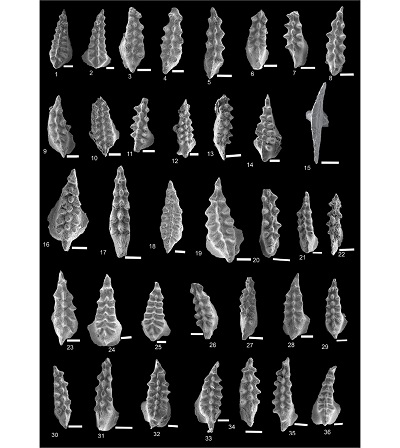 |
| Figure 6. Conodonts from Yazdanshahr No.2 section and sample numbers, respectively. 1, 2, 10, 25, Icriodus symmetricus symmetricus 55, 52, 34, 45; 3, 4, 6, 8, I. eslaensis 37, 34, 25; 5, 13, 35, I. alternatus costatus 29, 33, 28; 7, 11, 21, 22, I. brevis 22, 29, 26, 25; 9, Icriodus sp. 38; 12, Icriodus cf. eslaensis 38; 14, I. subterminus 22; 15, Bipennatus bipennatus 18; 16. I. alborzensis 24; 17, 20, 31, I. alternatus alternatus 56, 36, 39; 18, 24, 32, I. arkonensis 30, 21, 21; 19, 23, 26, 29, 33, I. expansus 22, 20, 29, 33, 20; 27, 30, I. alternatus 47, 45; 28, I. symmetricus 61; 34, I. brevis brevis 56; 36, Icriodus corniger 25. Scale bars = 100 µ |
4.3. EXPANSUS ZONE (MIDDLE GIVETIAN)
This biozone starts with the firth appearance of the index genus Icriodus expansus (Narkiewicz and Bultynck, 2010; Bahrami et al., 2019), and continues to the base of the following zone which is recognized by the first appearance of the Icriodus subterminus (Sandberg and Dreesen, 1984; Narkiewicz and Bultynck, 2007; 2010; Bultynck and Gouwy 2008; Bahrami et al., 2019). Lithology of this biozone is gray brachiopod limestone, and abundant varieties of fossils that consist of brachiopoda, trilobites, coral, tetaculites and fish teeth. The collected elements in this part are related to Polygnathodontidae and Icriodontidae, and include the following genera: Icriodus (Branson and Mehl, 1934), Icriodus alternatus (Branson and Mehl, 1934), Icriodus alternatus cymbiformis (Branson and Mehl, 1938), Icriodus brevis (Stauffer, 1940), Icriodus brevis brevis (Stauffer, 1940), Icriodus brevis darbyensis (Klapper, 1958), Icriodus incrassatus (Youngquist and Peterson, 1947), Icriodus incrassatus incrassatus (Youngquist and Peterson, 1947), Icriodus arkonensis (Stauffer, 1948), Icriodus expansus (Branson and Mehl, 1938), Icriodus symmetricus (Branson and Mehl, 1934), Icriodus symmetricus expansus (Branson and Mehl, 1938), Polygnathus sp. (Hinde, 1879), Polygnathus varcus (Stauffer, 1940), Polygnathus rhenaus (Klapper et al., 1970), Polygnathus pseudofoliatus (Wittekind, 1966), Polygnathus xylus (Stauffer, 1940), Polygnathus latifosatus (Wirth, 1967), Polygnatus ovatinodosus (Ziegler and Klapper, 1976).
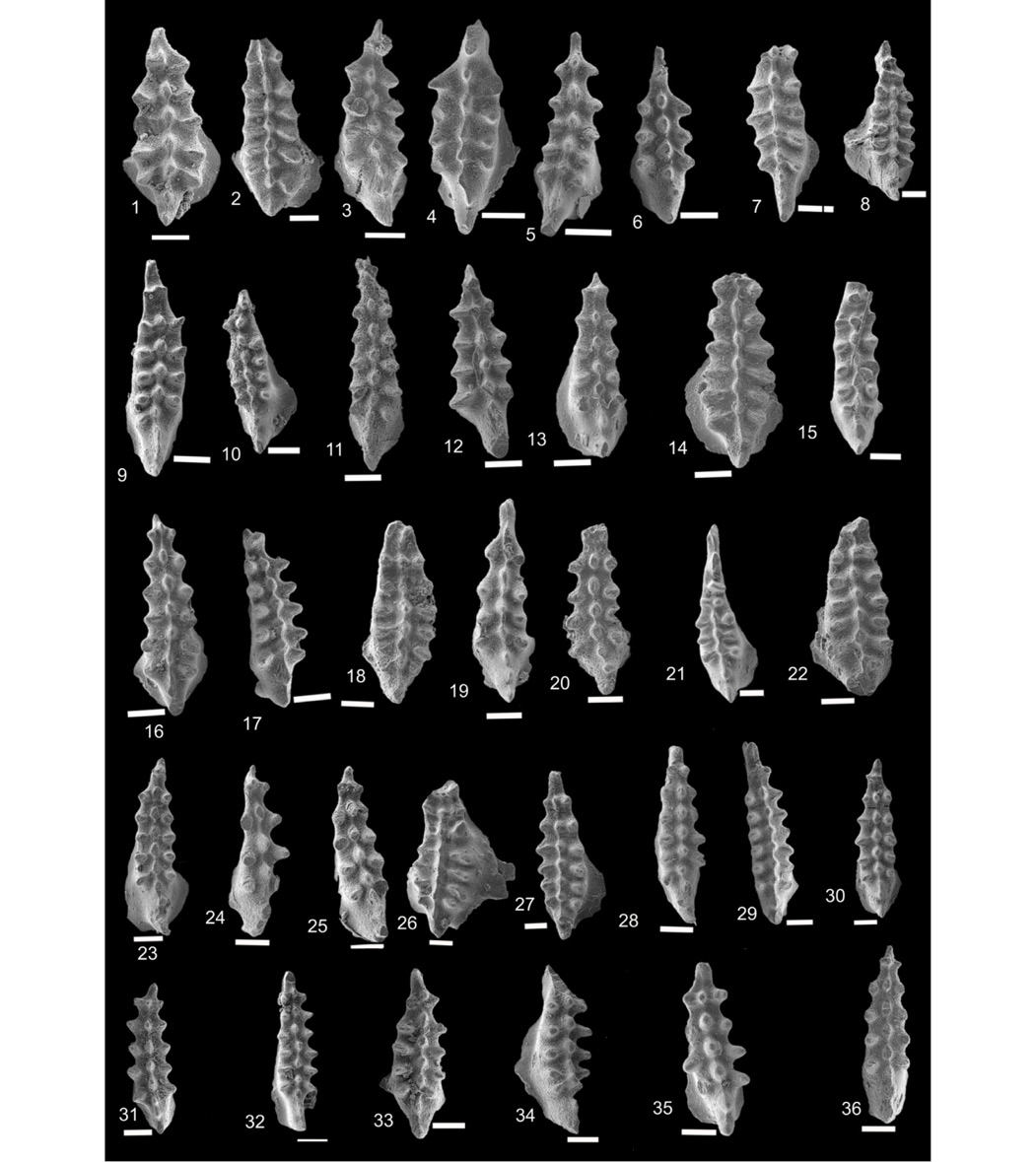 |
| Figure 7. Conodonts from Yazdanshahr No 2.section and sample numbers, respectively. 1, 3, 34, Icriodus expansus 28, 29, 59; 2, 14, 18, I. arkonensis 28, 25, 46; 4, I. cedarensis 33; 5, 6, 13, 17, 21, 20, 24, 25, I. brevis 24, 34, 25, 22, 52, 22, 25, 46; 7, Icriodus sp. 50; 8, 27, 29, I. symmetricus 42, 47, 38; 9, I. alternatus 29; 10, 35, I. brevis spicatus 21, 25; 11, 15, 30, I. alternatus alternatus 26, 36, 38; 12, 16, I. alternatus costatus 33, 25; 19, 31, 33, 28, I. brevis brevis 33, 26, 46, 52; 22, I. symmetricus symmetricus 28; 23, I. alternatus curvirostatus 24; 26, I. iowaensis 40; 32, I. altternatus cymbiformis 27; 36, 37, I. eslaensis 35, 42. Scale bars = 100 µ. |
4.4. SUBTERMINUS ZONE (MIDDLE TO LATE GIVETIAN)
The base of this zone is recognized by the first appearance of the Icriodus subterminus. This zone continues through the Givetian, and ends at the Givetian-Frasnian boundry, where the following zone starts with the first appearance of index genus Ancyrodella. Lithology of this biozone is gray to dark brachiopoda limestone. The elements collected in this biozone are the following genera: Icriodus alternatus (Branson and Mehl, 1934), Icriodus alternatus cymbiformis (Branson and Mehl, 1938), Icriodus brevis (Stauffer, 1940), Icriodus brevis brevis (Stauffer, 1940), Icriodus brevis darbyensis (Klapper, 1958), Icriodus incrassatus (Youngquist and Peterson, 1947), Icriodus incrassatus incrassatus (Youngquist and Peterson, 1947), Icriodus arkonensis (Stauffer, 1940), Icriodus expansus (Branson and Mehl, 1938), Icriodus symmetricus (Branson and Mehl, 1934), Icriodus symmetricus expansus (Branson and Mehl, 1938), Polygnathus sp. (Hinde, 1879), Polygnathus varcus (Stauffer, 1940), Polygnathus rhenaus (Klapper et al., 1970), Polygnathus pseudofoliatus (Wittekind, 1966), Polygnathus xylus (Stauffer, 1940), Polygnathus latifosatus (Wirth, 1967), Polygnatus ovatinodosus (Ziegler and Klapper, 1976).
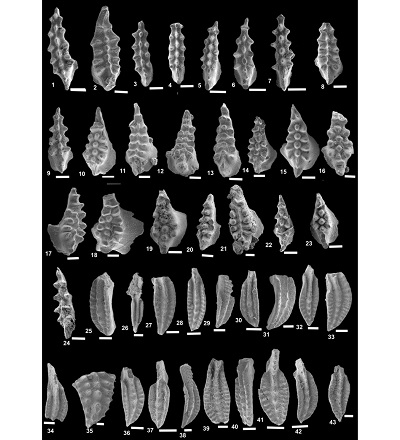 |
| Figure 8. Conodonts from Yazdanshahr No2.section and sample numbers, respectively. 1, Icriodus eslaensis 26; 2, 8, I. arkonensis 45, 45; 3, 5, 24, I. alternatus costatus 24, 38, 55; 4, I. alternatus alternatus 46; 6, I. brevis 45; 7, 30, I. alternatus 28, 38; 9, I. brevis spicatus 34; 10, 12, 20, 21, 23, I. subterminus 56, 22, 25, 26, 33; 11, I. expansus 58; 13, I. difficilis 22; 14, I. orri 22; 15, 18, 19, I. excavatus 27, 36, 36; 16, I. alborzensis 26; 17, 22, Icriodus sp. 25, 45; 25, 42, Polygnathus sp. 36,36; 26, P. brevilamminus 33; 27, 31, 34, 36, P. webbi 24, 22, 44, 55; 28, 33, P. politus 26, 34; 29, 38, 40, P. xylus 22, 22, 44; 39, 43, P. pseudofoliatus 22, 26; 32, P. dubius 26; 35, Ancyrodella sp. 66; 37, Polygnathus alatus 22; 41, P. ovatinodosus 36.Scale bars = 100 µ. |
- 5.FALSIOVALIS TO CREPIDAZONE? (ANCYRODELLA, POLYGNATHUS INCOMPLETUS ASSEMBLAGE ZONE)
This zone is recognized based on the assemblage of the index taxa Ancyrodella and Polygnathus incompletus, but the lower limit is marked by index genus Ancyrodella at the Frasnian-Famenian boundry. Lithology of this biozone is soft argillaceous red sandstone with marly limestone. The elements collected in this part include the followings genera: Polygnathus incompletus (Uyeno, 1967), Icriodus brevis (Stauffer, 1940), Ancyrodella routondiloba (Bryant, 1921), Polygnathus varcus (Stauffer, 1940), Icriodus alternatus alternatus (Branson and Mehl, 1934). Age of this biozone is Givetian (falsovalis Zone) to Frasnian? (crepida Zone?).
 |
| Figure 9. Conodonts from Yazdanshahr No2.section and sample numbers, respectively. 1, 4, 9, Icriodus alternatus alternatus 46, 56, 46; 2, 7, 13, 14, I. subterminus 45, 30, 24; 3, I. alternatus costatus 46; 5, 12, 25, 28, 32, Icriodus sp. 36, 26, 28 22, 26; 6, 8, I. iowaensis 30, 36; 15, 16 Polygnathus berevilamminus 42, 44;17, 34, 35, 37, P. webbi 36, 42, 44, 38; 18, P. politus 28; 19, 20, 26, 31, P. decorsus 28, 34, 42, 48; 20, 33, Ancyrodella sp. 68, 66; 21, 30, Polygnathus xylus 48, 50; 22, 23, 24, Fish teeth 22, 22, 26; 27, Polygnathus sp 26; 29, Trichonodella sp. 50; 36, Polygnathus varcus 26. Scale bars = 100 µ. |
- Conclusion
The studied section, Yazdanshahr No.2, is located in the northwest of Kerman; south of Central Iranian plate. Central Iran Plate belonged to the northern margin of Gondwana Until Early Carboniferous, and then has been separated from Gondwana, and joined Lurazia in the Late Triassic. Lower Devonian sediments in Yazdanshahr section (mostly section No.1) consist of continental evaporitic and detritic sediments (gypsum and red sandstone) with rare intercalation of carbonate layers (Padehat Formation). These facies have been deposited in a supratidal environment, and the age of the sediment (Padehat Formation in 5 specified. the upper limit of Padehat Formation was determined by The beginning point of transitional zone (Sandstone to Dolomite), which started with Sibzar Dolomite, and was considered as The boundary between Padehat and Sibzar formations, which can also be recognised by Bipennatus and Icriodus bearing transgrative deposits at the base of the Sibzar Formation. Nonetheless, based on previous study (Nasehi, 2018) and field information obtained from present study, the probable age of Padehat Formation can be considered from Emsian to Eifelian. The Sibzar Formation which overlay the Padehat Formation, mostly consists of middle devonian dolomite and limy dolomite with intercalation of sandstone and limestone layers, which has been overlain by fossiliferous carbonate deposits of The Bahram Formation. Due to the assemblages of Genus Bipennatus bipennatus and the family Icriodontidae including Icriodus regularicresens, Icriodus brevis and Icriodus brevis spicatus, the age of the Sibzar Formation is considered to be Eifelian (serotinus?/costatus Zone to varcus Zone (Bipennatus, Icriodus regularicresens Assemblage Zone). Bahram Formation mostly consists of fossiliferous limestone and intercalation of sandstone and dolomitic limestone. Four biozone were distinguished in Bahram Formation in Yazdanshahr No. 2 section. The first biozone starts with genus Polygnathus varcus (varcus Zone), which starts at lower Givetian, and ends at middle Givetian where Icriodus expansus is appeared in sediments. Second biozone starts with the first appearance of Icriodus expansus (expansus Zone), which starts at the middle Givetian and ends at the base of the upper Givetian, where Icriodus subterminus is appeared in sediments. Third biozone is distinguished with the first appearance of Icriodus subterminus (subterminus Zone) at the base of upper Givetian, and continues to the base of lower Frasnian where genus Ancyrodella appeared in the sediments. Last biozone, which continues to the end of the section recognized by the first appearance of genus Ancyrodella and Polygnathus incompletus. Consequently, the age of Bahram Formation is considered to be the span of Givetian to Frasnian in Yazdanshahr No.2 section.
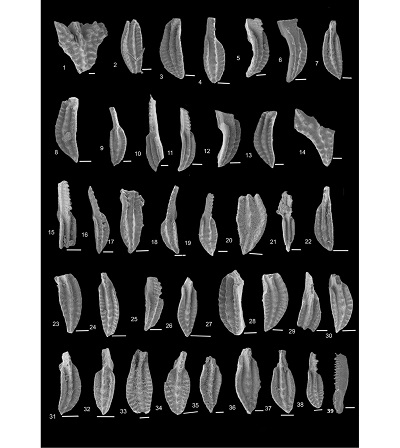 |
| Figure 10. Conodonts from Yazdanshahr No2. section and sample numbers, respectively. 1, 14, Ancyrodella sp. 68, 66; 2, 3, 9, 12, 23, 29, 30, 38, Polygnathus webbi 36, 26, 40, 26, 32, 22, 46, 28; 4, 19, P. decorsus 40, 34; 5, 6, 8, 10, 13, 15, 25, P. xylus 25, 36, 36, 28, 22, 33, 26; 7, 33, P. dubius 24, 26; 11, 16, 24, 28, P. politus 28, 36, 40, 40; 17, 20, 36, 37, P. aequalis 44, 26, 42, 36; 18, P. timoirensis 44; 21, P. brevilamminus 22; 22, 26, 32, P. alatus 30, 22, 43; 27, 31, Polygnathus sp. 28, 36; 4, P. ovatinodosus 44; 35, P. pseudofoliatus 46; 39, P. varcus 24. Scale bars = 100 µ. |
Contribution of authors
First author (E. Nasehi): writing of the original manuscript, financing, analysis, fieldwork, technical development and interpretation. Second author (M. A. Nasehi): writing of the corrected and edited manuscript, analysis, interpretation, graphic design.
Financing
Personal funding.
Acknowledgments
Both authors thank anonymous reviewers for their strong and constructive comments. We are also indebted for the helpful comments by Dr. Francisco J. Vega, the Editor-in-Chief of Boletín de la Sociedad Geológica Mexicana, and his kindness and patience during the revision process.
Conflicts of interests
The authors declare that they have no conflict of interest.
References
Ahmadi, T., Dastanpour, M., Vaziri, M.R., 2012, Upper Frasnian (upper Devonian) Polygnathus and Icridus conodonts from the Bahram Formation, Hur section, Kerman province, Southeastern Iran: Rivista Italiana di Paleontologia e Stratigrafia, 118 (2), 203-213.
Ahmadzadeh-Heravi, M., 1971, Stratigraphische und paläontologische Untersuchungen im Unterkarbon des zentralen Elburs (Iran): Clausthaler Geologische Abhandlungen 7, 1-114.
Ahmadzadeh-Heravi, M., 1975, Stratigraphie und Fauna im Devon des östlichen Elburz, (Iran): Clausthaler Geol Abh,23, 1–114
Alavi-Naini, M., 1993, Paleozoic stratigraphy of Iran, in Hushmandzadeh, M. (ed.), Treatise on the Geology of Iran: Tehran, Iran, Geological Survey of Iran, 5, 492p.
Ashouri, A.R., 1990, Devonian and Carboniferous Conodont Faunas from Iran: England, University of Hull, Ph.D. Thesis, 351p.
Ashouri, A.R., 2004, Late Devonian and Middle-Late Devonian conodonts from eastern and northern Iran: Revista Española de Micropaleontología, 3, 355-365.
Ashouri, A.R., 2006, Middle Devonian-Early Carboniferous conodont faunas from the Khoshyeilagh Formation, Alborz Mountains, north Iran: Journal of Sciences, 17, 53-65.
Assereto, R., 1963, The Paleozoic formations in central Elburz (Iran): Rivista Italiana di Paleontologia e Stratigrafia, 69, 503-543.
Bahrami, A., Corradini, C., Yazdi, M., 2011a, Upper Devonian-Lower Carboniferous conodont biostratigraphy in the Shotori Range, Tabas area, Central-East Iran Microplate: Bollettino della Società Paleontologica Italiana, 50(1), 35-53. https://doi.org/10.22108/jssr.2020.119411.1120
Bahrami, A., Gholamalian, H., Corradini, C., Yazdi, M., 2011b, Upper Devonian conodont biostratigraphy of ShamsAbad section, Kerman Province, Iran: Rivista Italiana di Paleontologia e Stratigrafia,117(2), 199-209. https://doi.org/10.13130/2039-4942/5971
Bahrami, A., Corradini, C., Over, D., Yazdi, M., 2013, Conodont biostratigraphy of the upper Frasnian-lower Famennian transitional deposits in the Shotori Range, Tabas area, Central-East Iran Microplate: Bulletin of Geosciences, 88, 369-388. https://doi.org/10.3140/bull.geosci.1353
Bahrami, A., Zamani, F., Corradini, C., Yazdi, M., Ameri, H., 2014, Late Devonian (Frasnian) conodonts from the Bahram Formation in the Sar-e-Ashk Section, Kerman Province, Central-East Iran Microplate: Bollettino della Società Paleontologica Italiana, 53(3), 179-188. https://doi.org/10.4435/BSPI.2014.15
Bahrami, A., Königshof, P., Boncheva, I., Tabatabaei, M.S., Yazdi, M., Safari, Z., 2015, Middle Devonian (Givetian) conodonts from the northern margin of Gondwana (Soh and Natanz regions, north-west Isfahan, Central Iran): biostratigraphy and palaeoenvironmental implications: Palaeobio Palaeoenv, 95, 555–577. https://doi.org/10.1007/s12549-015-0205-0
Bahrami, A., Königshof, P., Boncheva, I., Yazdi, M., Safari, Z., 2018, Conodont biostratigraphy of the Kesheh and Dizlu sections, and the age range of the Bahram Formation in central Iran: Palaeobio Palaeoenv, 98, 315–329. https://doi.org/10.1007/s12549-017-0307-y
Bahrami, A., Königshof, P., Vaziri-Moghaddam, Shakeri, Bahar., 2019, Conodont stratigraphy and conodont biofacies of the shallow-water Kuh-e-Bande-Abdol-Hossein section (SE Anarak, Central Iran): Palaeobiodiversity and Palaeoenvironments, 99, 477-494. https://doi.org/10.1007/s12549-019-00384-5
Bahrami, A., Parast, A., Boncheva, I., Yazdi, M., 2020, Late Devonian (Famennian) conodonts from Baqer-Abad section, northeast Isfahan province, Central Iran: Boletín de la Sociedad Geológica Mexicana, 72 (2), A100619. http://dx.doi.org/10.18268/ BSGM2020v72n2a100619
Bischoff, G., Ziegler, W., 1957, Die Condontenchronologie des Mittel – devons und des tiefsten Oberdevons: Abhandlungen des Hessischen Landesamtes für Bodenforschung, 22, 1-136.
Boncheva, I., Bahrami, A., Yazdi, M., Torabi, H., 2007, Carboniferous conodont biostratigraphy and late Paleozoic depositional evolution in South Central Iran (AsadAbad section – SE Isfahan): Rivista Italiana di Paleontologia e Stratigrafia, 113, 329-356. https://doi.org/10.13130/2039-4942/5879
Bozorgnia, F., 1973, Paleozoic Foraminiferal Biostratigraphy of Central and East Alborz Mountains, Iran: National Iran Oil Company Press, 185 p.
Branson, E.B., Mehl, M.G., 1934, Condonts from the Bushberg Sandstone and equivalent formation of Missouri: University of Missouri Studies, 8, 265-299.
Branson, E.B., Mehl, M.G., 1938, The conodont genus Icriodus and its stratigraphic distribution: Journal of Paleontology, 12, 156-166.
Brice, D., Mistiaen, B., Rohart, J.C., 1999, New data on distribution of brachiopods, rugose corals and stromatoporoids in the Upper Devonian of central and eastern Iran. Paleobiogeographic implications: Annales de la Sociètè gèologique du Nord, 7, 21-32.
Brice, D., Kebriaei, M., 2000, A new species of Leiorhynchiidae rhynchoneliid brachiopod from the Frasnian of Chahriseh, Esfahan Province, Central Iran: Annales de la Sociètè gèologique du Nord, 8(2), 61-65.
Bryant, W.L., 1921, The Genesee conodonts with descriptions of new species: Buffalo Society of Natural Sciences Bulletin, 13(2), 1-59.
Bultynck, P., 1970, Revision stratigraphique et paleontologyque (Brachiopodes et Condontes) de la cou type du Couvinien. –Mem: Inst. Geol. Univ. Louvain 26, 152p.
Bultynck, P., Gouwy, S., 2008, Reference sections for the Middle Givetian Substage. Subcommission on Devonian Stratigraphy: Newsletter, 23, 21-26.
Clausen, C.D., Weddige, K., Ziegler, W., 1993, Devonian of the Rhenish Massif: Subcommission on Devonian Stratigraphy, Newsletter 10, 18–19.
Dastanpour, M., 1996, Late Devonian reef in north Kerman province: Journal of Science, (University of Tehran), 22(1), 1-11.
Dastanpour, M., 1998, Study on upper Devonian brachiopods of northeast of Baghin Kerman: Journal of Science, (University of Tehran), 22(1), 13-27.
Dastanpour. M., 1999, the late Devonian Coral in east Hojedk anticline (Kerman): proceeding on 4th anniversary Geological Society of Iran congress, Tabriz University,102-1039.
Gaetani, M., 1965, The geology of the upper Djadjerud and Lar valleys (North Iran); II Paleontology; Brachiopods and molluscs from Geirud Formaion, Member A, (Upper Devonian and Tournaisian): Rivista Italiana di Paleontologia e Stratigrafia, 71(3), 679-755.
Ghavidel-Syooki, M., 1997, Acritarch biostratigraphy of the Palaeozoic rock units in the Zagros Basin, southern Iran: Acta Universitatis Carolinae, Geologica, 40, 385-411.
Ghavidel-Syooki, M., 2001, Palynostratigraphy and palaeogeography of the Late Devonian strata in northeastern Esfahan city, Central Iran in Proceeding of the IX International Palynology Congress, Houston, Texas, 1996, USA, American Association of Stratigraphic Palynologists Foundation, 37–51.
Gholamalian, H., 2005, New data on the Famennian conodonts from Esfahan area, central Iran: Iranian International Journal of Sciences, 6(1), 27-45.
Gholamalian, H., 2007, Conodont biostratigraphy of the Frasnian-Famennian boundary in the Esfahan and Tabas areas, central Iran: Geological Quarterly, 51, 453-476.
Gholamalian, H, Kebriaei, M.R., 2008, Late Devonian conodonts from the Hojedk section, Kerman Province, southeastern Iran: Rivista Italiana di Paleontologia e Stratigrafia, 114, (2), 171-181 https://doi.org/10.13130/2039-4942/5898
Hairapetian, V., Yazdi, M., Long, J., 2000, Devonian vertebrate biostratigraphy of central Iran: Records of the Western Australian Museum Supplement, 58, 241-248.
Hairapetian, V., Yazdi, M., 2003, Late Devonian conodonts from the Dalmeh sections, Northeast Ardekan, Central Iran: Courier Forschungsinstitut Senckenberg, 245, 209-225.
Hamdi, B., Janvier, P., 1981, Some conodonts and fish remains from Lower Devonian (Lower part of the Khoshyeylaq Formation) North East Shahrud, Iran: Geological Survey of Iran Reports 49, 195-213.
Huckriede, R., Kürsten, M., Venzlaff, H., 1962, Zur Geologie des Gebietes zwischen Kerman und Sagand (Iran): Beihefte zum Geologischen Jahrbuch, 51, p.197.
Hashemi, H., Playford, G., 1998, Upper Devonian palynomorphs of the Shishtu Formation, central Iran Basin, east-central Iran: Palaeontographica, Abt. B, 246, 115-212.
Hinde, G.J., 1879, On conodonts from the Chazy and Cincinnati group of the Cambro-Silurian and from the Hamilton and Genesee shale divisions of the Devonian in Canada and the United States: Geological Society of London Quarterly Journal, 35(3), 351-369.
Klapper, G., 1958, An upper Devonian conodont founa from the Darby Formation of the wind river mountain,Wyoming: Journal of Paleontology, 32, 1082-1093.
Klapper, G., Philip, G.M., Jakson J.H., 1970, Revision of the Polygnathus varcus Group (Conodonta, Middle Devonian): Neues Jahrbuch für Geologie und Paläontologie, Monats-hefte, Jahrgang, (11), 650-667.
Klapper, G., Ziegler, W., 1979, Devonian conodont biostratigraphy: Special Paper on Palaeontology, 23, 199–224.
Königshof, P., Carmichael, S.K., Waters, J., Jansen, U., Bahrami, A., Boncheva, I. Yazdi, M., 2017, Palaeoenvironmental study of the Palaeotethys Ocean: The Givetian-Frasnian boundary of a shallow-marine environment using combined facies analysis and geochemistry (Zefreh Section/ Central Iran), in Mottequin, B., Slavik, L., Königshof, P., (eds.), Climate change and biodiversity patterns in the mid-Paleozoic: Palaeobiodiversity and Palaeoenvironments, 97(3), 517–540.
Loftus, W.K., 1855, On the geology of portions of the Turko-Persian frontier, and of the districts adjoining: Quarterly Journal of the Geological Society, 11(1-2), 247-344. https://doi.org/10.1144/GSL.JGS.1855.011.01-02.33
Najjarzadeh, M., Ashouri, A., Yazdi, M., Bahrami, A., 2020, Biostratigraphy of Devonian-Carboniferous boundary in Tuyeh-Darvar section, north of Iran: Iranian Journal of Earth Sciences, 12(2), 98-123. https://doi.org/10.30495/ijes.2020.673332
Narkiewicz, K., 2011, Biostratygrafia konodontowa Dewonu rodkowego obszaru Radomsko-Lubelskiego: Prace Panstwowego Instytutu Geologicznego, 196, 147-192.
Narkiewicz, K., Bultynck, P., 2007, Conodont biostratigraphy of shallow marine Givetian deposits from the Radom-Lublin area, SE Poland: Geology Quarterly, 51(4), 419-442.
Narkiewicz, K., Bultynck, P., 2010, The Upper Givetian (Middle Devonian) subterminus conodont zone in North America, Europe,and North Africa: Journal of Paleontology, 84(4), 588-625. https://doi.org/10.1666/10-029.1
Nasehi, E., 2018, New biostratigraphical findings on the Padeha formation based on conodont accumulation in Yazdanshahr, Kerman, central Iran: Applied Ecology and Environmental Research, 16(2) 993-1018. 10.15666/aeer/1602_9931018.
Philip, GM., 1965, Lower Devonian conodonts from the Tyers area, Gippsland, Victoria: Proceedings of the Royal Society of Victoria 79, 95-117.
Ruttner, A., Nabavi, M., Hajian, J., 1968, Geology of the Shirgesht area (Tabas Area, East Iran): Tehran, Iran: Ministry of Economy, Geological Survey of Iran, 4, 1-133.
Stauffer, C.R., 1940, Conodonts from the Devonian and associated clays of Minnesota: Journal of Paleontology, 14, 417-435.
Stöcklin, J., Eftekhar-Nezhad, J., Hushmand-Zadeh, A., 1965, Geology of the Shotori range (Tabas area, east Iran): Geological Survey of Iran, Reports, 3, 1-69.
Stöcklin, J., 1971, Stratigraphic Lexicon of Iran. Part 1: Central, North, and East Iran: Geological Survey of Iran, Reports 18, 1-338.
Sandberg, Ch., Dreesen, R., 1984, Late Devonian icriodontid biofacies models and alternate shallow-water conodont zonation: Special Paper of the Geological Society of America, 196, 143-178. https://doi.org/10.1130/SPE196-p143
Viquesnel, A., 1850, Notice sur la collection de roches recuillie en Asie par feu Hommaire de Hell, et sur les divers travaux exécutés pendant le cours de son voyage: Bulletin de la Societé Géologique de France, Série, 2(7), 491-514.
Walliser, O.H., 1966, Preliminary notes on Devonian, Lower and Upper Carboniferous goniatites in Iran: Geological Survey of Iran, Report, 6, 7-24.
Weddige, K., 1977, Die Conodonten der Eifel-Stufe im Typusgebiet und in benachbarten Faziesgebieten: Senckenbergiana Lethaea, 58, (4-5), 271-419.
Weddige, K., 1984, Zur Stratigraphie und Paläogeographie des Devons und Karbons von NE-Iran: Senckenbergiana Lethaea, 65, 179-223.
Webster, G.D., Maples, C.G., Mawson, R., Dastanpour, M., 2003, A cladial-dominated lower Misssisipian crinoid and conodont founa from Kerman province, Iran and revision of the glossocrinids and rhenocrinids: Journal of Paleontology, 77, 1-35.
Wendt, J., Kaufmann, B., Belka, Z., Farsan, N., Karimi. Bavandpur, A., 2005, Devonian/lower carboniferous stratigraphy, facies patterns and palaeogeography of Iran. Part II. Northern and Central Iran: Acta Geologica, 55, 31-97.
Wirth, M., 1967, Zur Gliederung des hoiheren Palaiozoikums (Givet-Namur) im Gebiet des QuintoR eal (Westpyrenaen) mit Hilfe von Conodontens: Neues Jahrbuch flir Geologie und PaIaontologie, Abhandlungen, 127(2), 179-244.
Wittekind, H.,1966, Zur Conodontenchron ologie des Mitteldevons. Jn Das Mitteldevon des Rheinischen Schi efergebirges, in Symposium, Fortschritte in der Geologie von Rheinland und Westfalen, 9, 621-646.
Youngquist, W.L., 1947, A new Upper Devonian conodont fauna from Iowa: Journal of Paleontology, 21(2), 95-112.
Youngquist, W.L., Peterson, R.F., 1947, Condonts from the Sheffield Formation of north-central lowa: Journal of Paleontology, 14, 417-435.
Yazdi, M., 1999, Late devonian-carboniferous conodonts from Eastern Iran: Rivista Italiana di Paleontologia e Stratigrafia, 105, 167-200.
Zamani, F., Yazdi, M., Bahrami, A., Girard, C., Spalletta, C., Ameri, H., 2020, Middle Givetian to late Famennian (Middle to Late Devonian) conodonts from the northern margin of Gondwana (Kerman region, Central Iran): Historical Biology, 33 (11), 2591-2609 https://doi.org/10.1080/08912963.2020.1819997
Ziegler, W., Klapper, G., 1976, Systematic paleontology, in Ziegler, W., Klapper, G., Johnson, J.G., (eds.), Redefinition and subdivision of the varcus-Zone (Conodonts, Middle-? Upper Devonian) in Europe and North America: Geologica et Palaeontologica, Marburg, 10, 117-127.
Peer Reviewing under the responsibility of Universidad Nacional Autónoma de México.
This is an open access article under the CC BY-NC-SA license(https://creativecommons.org/licenses/by-nc-sa/4.0/)

